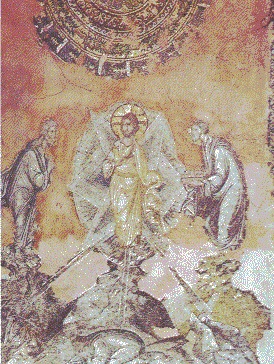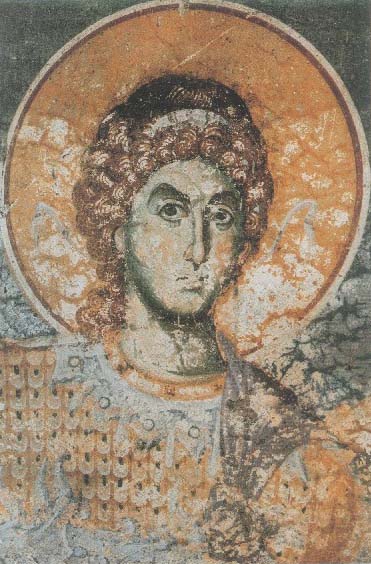 |
| St Lukas, Viotia |
Η ζωγραφική και οι εικαστικές τέχνες γενικά, του Ελληνικού κόσμου γνώρισαν μεγάλες διακυμάνσεις από την Ελληνιστική εποχή και μετά. Κατά την περίοδο της Μακεδονικής ηγεμονίας η ζωγραφική φτάνει σε πολύ υψηλό επίπεδο όπως μαρτυρούν τα ψηφιδωτά και οι τοιχογραφίες της Πέλλας και της Βεργίνας. Η παράδοση μεταφέρθηκε και στον Ρωμαϊκό κόσμο
και με την γέννηση της Βυζαντινής Αυτοκρατορίας μετατρέπεται σιγά-σιγά σε θρησκευτική-λατρευτική τέχνη από
κοσμική που ήταν. Οι σωζόμενες τοιχογραφίες από παλαιοχριστιανικές εκκλησίες σε διάφορα νησιά του Αιγαίου μαρτυρούν την διατήρηση της Ελληνιστικής παράδοσης μέχρι τον 6ο-7ο αιώνα. Την εποχή αυτή ημιουργήθηκαν πολλές εικόνες με τη μεθοδο της εγχυσης - λειωμένο κερί ανακατεμένο με χρώμα. Στη συνέχεια ακολουθεί η περίοδος της Εικονομαχίας (726-842μ.Χ.) κατά την οποία καταστράφηκαν πολλά έργα τέχνης ενώ παράλληλα, που είναι και το χειρότερο, η ζωγραφική έχασε την δυναμική της και. Με την αποκατάσταση των εικόνων, η τέχνη της ζωγραφικής έπρεπε να αρχίσει από την αρχή και να δημιουργήσει εκ νεου τους κανόνες της.
 |
| St Lukas, Viotia |
 |
| St George, Kurbinovo |
 |
| Monastery of Chora |
Η δέυτερη μεγάλη άνθηση εμφανίζεται την περίοδο των Παλαιολόγων με τη ζωγραφική να επιστρέφει στις αρχαιοελληνικές ρίζες της και τις ανθρωπιστικές αρχές να γίνονται φανερές στην ψυχολογία των μορφών. Την εποχή αυτή ξεχωρίζουμε τον κυρ-Μανουήλ Πανσέληνο με τις υπέροχες τοιχογραφίες του στο Πρωτάτο το Αγίου Όρους και τους Μιχαηλ Αστραπά και Ευτύχιο από τη Θεσσαλονίκη (Αγιος Κλήμης Αχρίδας). Η συγκεκριμένη τέχνη συναντάται κυρίως στην Βόρεια Ελλάδα και συνιστά την λεγόμενη Μακεδονική Σχολή (οι τοιχογραφίες στον ναό των
 |
| Monastery of Chora |
 |
| Monastery of Chora |
 |
| St Nicholas the Orphan, Thessaloniki |
Η Κρητική Σχολή έδωσε κυρίως εικόνες και έβγαλε μεγάλους ζωγράφους (Θεοφάνης Στρελίτζας με τοιχογραφίες στη Μονή Μεγίστης Λαύρας και Σταυρονικήτα στο Αγιο Όρος) και εικονογράφους. Οι Κρητικοί τεχνίτες δούλευαν κυρίως με Ιταλούς πελάτες και γι αυτό σιγά-σιγά άρχισαν να δέχονται και Ιταλικές επιρροές.
 |
| St Nicholas the Orphan, Thessaloniki |
Τα πιο γνωστά ονόματα της Κρητικής Σχολής είναι οι Παβίας, Ρίτζος, Τζάνες, Δαμασκηνός, ενώ και ο Θεοτοκόπουλος καταγράφεται μεταξύ των καλλιτεχνών της Kρήτης πριν από την Οθωμανική κατάληψη.
Μετά την κατάληψη της Κρήτης από τους Οθωμανούς οι περισσότεροι καλλιτέχνες μεταναστευσαν στα Επτάνησα και το εξωτερικό.  |
| St Nicholas the Orphan, Thessaloniki |
18. Byzantine and Post-Byzantine Painting
Painting and generally the figurative arts of the Greek world went through a number of fluctuations from the Hellenistic period and afterwards. During the period of the Macedonian domination in Greece, the art of painting
 |
| St Nicholas the Orphan, Thessaloniki |
The tradition was tranferred to the Roman world and with the emergence of the Byzantine Empire was transfigured slowly from secular into religious-worshiping art. The frescoes that are saved in Paleo-christian churches in various islands of the Aegean witness the maintenance of the Hellenistic tradition until the 6th-7th century. That period
 |
| Sopocani, Serbja |
Next, the period of Iconomachy follows (726- 824A.D.) when many masterpiecees were destroyed, while at the same time, which was worse, painting lost its momentum.
 |
| Sopocani, Serbja |
So, the first paintings after the Iconomachy were linear- two-dimensional, with stressed outline and with the human figures austere and wthout psychological traits. The mosaic at the altar of St Sophia in Thessaloniki and the frescoes of St Lukas in Viotia are characteristic.
 |
| St Apostles, Thessaloniki |
 |
| St Apostles, Thessaloniki |
the Crusaders, the human figures became more nervous, their garments swirling in a first-
 |
| Manouil Panselinos |
and St Anargyroi - Kastoria, St George-Kurbinovo near Prespa in FYROM, Holy Mary of Araakos-Cyprus). | |
|
This style proves with the most eloquent way how mass psychology affects Art and its centrifugal nature spread it beyond the Greek peninsula, in
Cyprus and Southern Italy and beyond the Greek world.
 | |
|
The second big flourish came during the Palaiologos governance and is a total return to the ancient Greek humanistic principles with psychological traits in the faces and body movements.
During this period we can distinguish Manouel Panselinos who created the wonderful frescoes at Protato (the building of administration of Athos -Agion Oros) and Michael Astrapas and Eftichios from Thessaloniki (they painted the church of St Clement in Ochrid). The specific style was mainly developed in
 | |
|
 | |
|
 |
| Pantanassa, Mystras |
 |
| Pantanassa, Mystras |
No comments:
Post a Comment